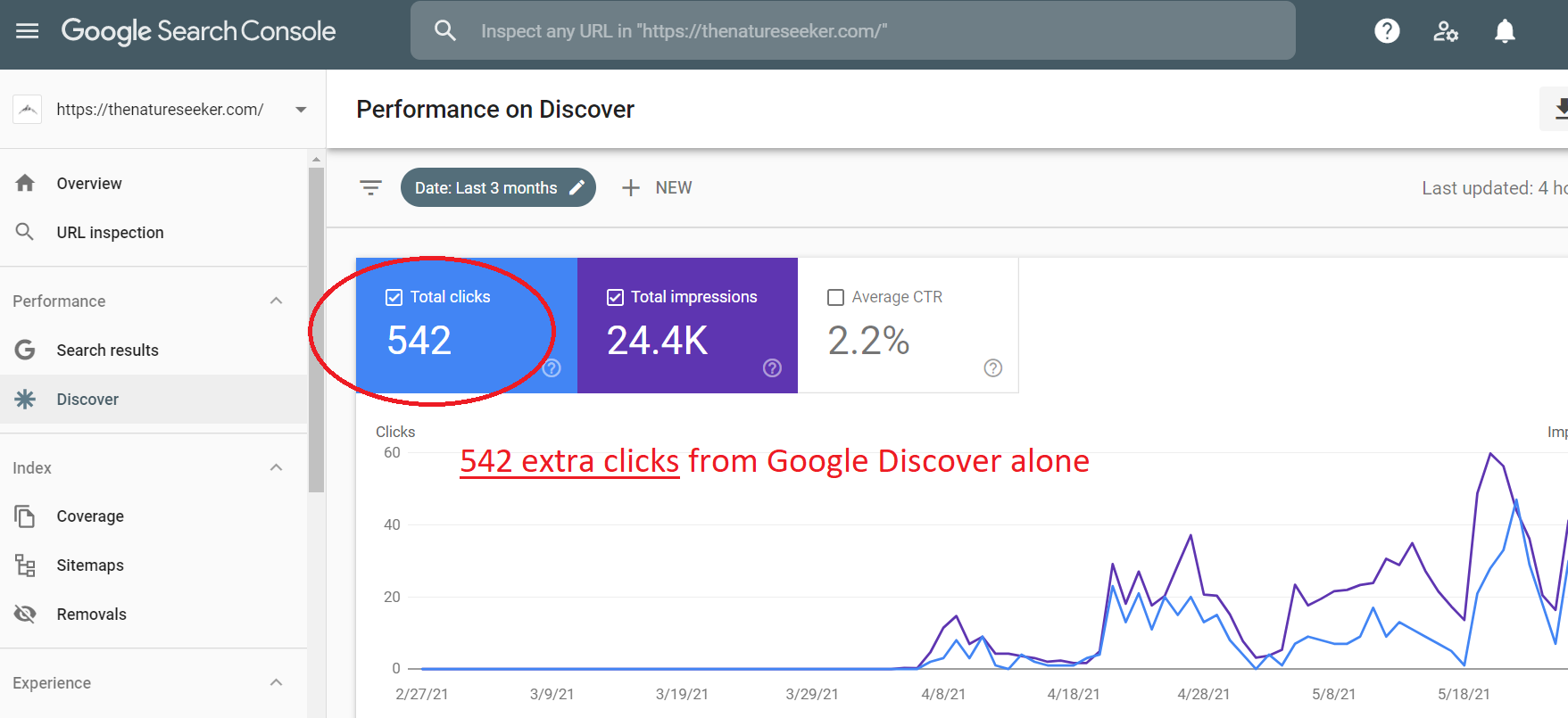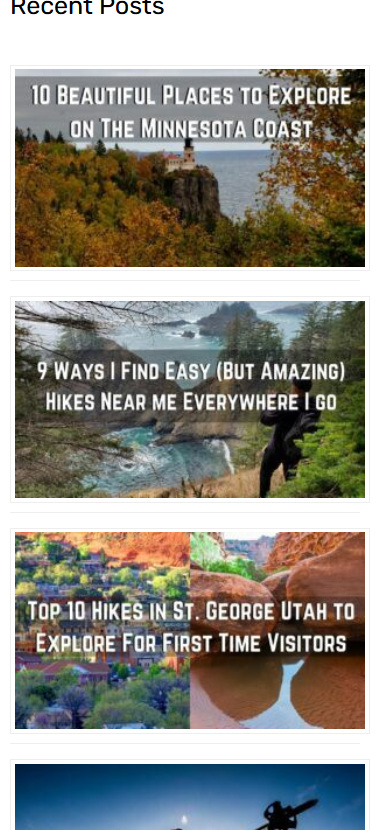Recently I discovered (no pun intended) that one of my blogs was getting search traffic with a new feature called Google Discover. After learning about what it was, I figured why that was the case and want to share how you can achieve SEO success with this branch of the search engine too.
The great news is that if your site is already being displayed on Google Discover, there’s really not much else you need to do as you’ll see, but if you’re not seeing this happen yet, the following SEO tips will help make that possibility (but not a guarantee).
Here is a video explaining Google Discover:
What is Google Discover?
It’s a new add on feature to the Google search browser that shows users links to article related to searches they’ve done on Google. This is basically Google’s way of showing you a kind of “you may find this interesting based on your search history” type of service.
This is also done on mobile devices (which plays an important role for SEO as we’ll discover soon). Here is the official Google Discover page.
With this new feature, users are shown results (they don’t type up searches to get Discover results).
How does Google discover work? Here is an example:
Let’s say someone opens up the Google search app and looks at sites related to the following topics: Nature, cooking and fitness. After finishing their searches, they hop off their phone and come back to it at a later time.
And when they return, and turn on their Google app again, underneath the search results will be sites (and images) showing related content to their 3 original topics (nature, cooking and fitness).
This is what Google Discovery does. It just shows you related sites based on your search history so you can consume more content.
What does Google Discover mean for SEO?
If you can have your website show up on Google Discover, it means 3 things are happening:
1) Your website’s SEO is already high enough to get good (basic) Google rankings.
2) Your site’s content is high quality and popular enough to be shown on Google Discovery.
3) You can get extra traffic from Google Discovery that you would otherwise not get from people browsing the regular Google search engine on their mobile device.
Bottom line: Being able to pop up on Google discovery means you can attract more traffic to your website.
My personal “run in” with Google Discover and how I learned about this:
As I said above, this came up as a pleasant surprise for me. I was doing a session with affiliate marketing coach and he was checking up on my Search Console results and noticed that one of my blogs (TheNatureSeeker.com) was showing discovery traffic there.
In fact, here is the screenshot of the traffic I am getting (only) from Google Discover:

From that point, he explained why this was and it gave me the knowledge I want to share with you today which is:
The 5 ways to get SEO success with Google Discover:

- Create great images with SEO titles.
- Target popular content that relies heavily on visuals.
- Make sure your site is mobile friendly (if it isn’t already).
- Make sure your site loads well (good hosting helps a lot).
- Do what already works for basic SEO success with blogging.
1) Create great images (and use SEO titles too):

One key feature of Google Discover is that it’s very image heavy and it’s more likely that your content (assuming it shows up on Google Discover) gets clicked on based on the image people see, not necessarily the title of the blog post associated with it.
With my nature blog, I have been heavily investing time and energy into creating awesome images and while that gets me results on places like Pinterest, it is of great help to get this Google Discover bonus for the same reasons too!
I usually take my own pictures, but if you’re not a nature person like me and your niche blog is in another category, use Canva.com. I often use that site for many of my images I can’t take on my own.
Additionally, keyword tags matter a lot here too because your image will rank for the keyword it’s associated with, giving it a better chance at showing up on Google Discover too.
For example:
- I make an image of a specific park in the United States.
- I’ll label that picture with the specific park.
- Then when someone looks up keywords for that park, if they don’t find me on regular Google search but find other blogs, I at least have a chance of popping up for them in Google Discover as a related search.
One awesome thing I discovered was that for my nature blog, a lot of my images were ranked (and getting traffic) from Google’s image search, which I suspect played a major role in the site getting the green light on discover.
2) Target popular content (visual heavy content also helps):
In the blogging world, you won’t find me saying anything is more than important than quality content, but certain niches and topics are just image heavy by nature (again no pun intended), and in this case, my nature page can’t just solely rely on having good content. It also needs to visually give people great image content as well to really mix well together.
If you are currently running a blog and you want to have a greater chance of showing up on Google Discover, your niche needs to be in a topic that naturally has a lot of images with it.
Now it’s true that pretty much all niche topics have images, but I’m talking about certain topics that just can’t survive on good content alone, let alone a few images.
I’m talking about stuff that when people see your content, the first thing they notice is the image and when they do searches, they look at images more so than the words of a site/blog.
Here are some examples:
- Nature (perfect example).
- Vacation travel.
- Cooking.
- Gaming.
- Fitness.
These topics alone carry so much image heavy potential that the more of it you create, the better the chances are Google will feel your site qualifies to be in their discovery search.
3) You have to have a mobile friendly site:

Not only is this mandatory for regular Google search, but considering Google Discover is 100% for mobile devices, why wouldn’t you want to ensure your site is mobile friendly?
This is the easiest thing to set up (one time with a good WordPress site) to at least check one box out of the necessities to be on Google Discover, so make sure you’re doing it.
4) Your site needs to load well (especially for mobile users):

A mobile friendly theme and a site loading well are not the same thing so make sure you have a good hosting account to go along with your site (in addition to being mobile friendly).
It’s well known that mobile devices don’t load up sites as quickly as desktop computers do, so making sure your site is set up in a way to load up quickly for mobile users is imperative.
Let’s not forget that an image heavy site (one of the essentials) is naturally going to lag on the site’s loading speeds.
So make sure a good hosting account (and correctly compressing images so they don’t lag the user’s experience are there) is there.
If you don’t have good hosting already, I recommend getting high speed hosting at Wealthy Affiliate.
For many of my images, I compress them from PNG to JPEG and Canva has this feature. You can also use good plugins to compress existing images on your site to help it’s speeds.
5) Do what already works for basic SEO/blogging:
In all honesty, if you are already doing the necessary things on your blog for good SEO results, then you are already raising your chances at getting Google discover to discover your site and use it in that browser.
For my nature site, I was literally just focusing on great content, great nature topics, all while being keyword focused on those topics I chose and everything else (mobile friendly and good hosting) were already in place. It’s no wonder this happened. If you need help with SEO, let me know below and I’ll write up extra content on this subject alone.
Understanding the big picture of Google Discover (and SEO success):
Ultimately, showing up on Google Discover is not something that is up to you. Google will decide if your website meets the criteria to be worthy of this.
At the same time, if you don’t see traffic or approval to have your site show up on Google Discover, don’t let it bother you. A lot of the traffic that comes to your site through this feature isn’t really all that interested in the content or site in general. They just saw a nice picture that got them to your site and that’s really it.
Now the big SEO benefits can come from Google Discover if the users who come to your site from there like the page, revisit it and share it and that can help in a big way make your site do much better in the original Google search.
At the end of the day, I would focus on having your site grow it’s authority in the regular Google search engine because that’s where most of your traffic will come from, including the most relevant one (which is what you want anyway).
Think of the Google search engine as 7 pieces to a pizza, and discover is just 1 slice. It certainly is better to have 8 slices vs 7, but even if you don’t get it, having 7 is more than enough to satisfy your hunger.
For example: I don’t expect this website to appear on Google Discover, nor would it really make a big difference if it did. I am focusing on building up the site with the most basic SEO strategies I know and this is really what the ultimate goal is with SEO.
